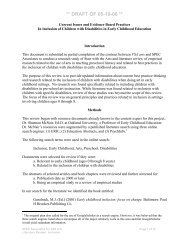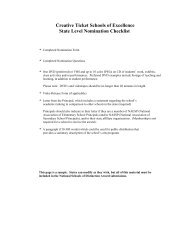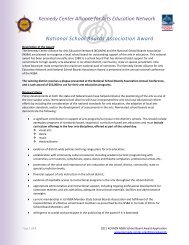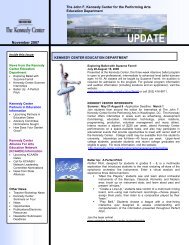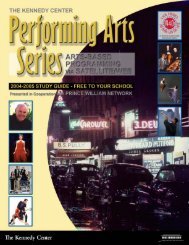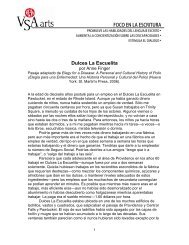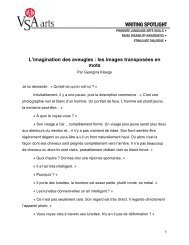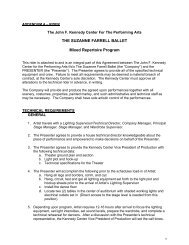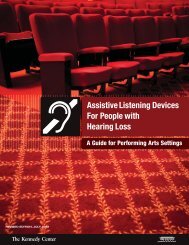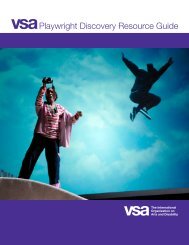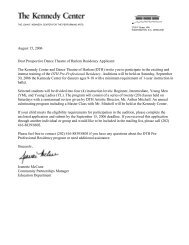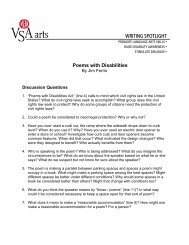Art Education for the 21st Century
Art Education for the 21st Century
Art Education for the 21st Century
You also want an ePaper? Increase the reach of your titles
YUMPU automatically turns print PDFs into web optimized ePapers that Google loves.
<strong>Art</strong> <strong>Education</strong> <strong>for</strong> <strong>the</strong> 21 st <strong>Century</strong><br />
Ellyn Gaspardi<br />
Ka<strong>the</strong>rine Douglas<br />
International VSA Festival<br />
Washington, DC 2010<br />
Introduction<br />
TEACHING FOR ARTISTIC BEHAVIOR (TAB) is a grassroots organization<br />
developed by and <strong>for</strong> teachers supporting choice-based art education. Studentdirected<br />
learning in art has been used in classrooms over 40 years as a successful<br />
pedagogy in a wide range of settings. Choice-based TAB studio classrooms allow<br />
<strong>for</strong> success on many levels <strong>for</strong> all learners, while encouraging practice in 21 st<br />
<strong>Century</strong> Skills, embedding Universal Design <strong>for</strong> Learning concepts and meeting<br />
guidelines <strong>for</strong> state visual art standards.<br />
CHOICE-BASED ART EDUCATION regards students as artists and offers <strong>the</strong>m<br />
real choices <strong>for</strong> responding to <strong>the</strong>ir own ideas and interests through <strong>the</strong> making of<br />
art. This concept supports multiple modes of learning and teaching <strong>for</strong> <strong>the</strong> diverse<br />
needs of students. The learning environment provides resources and opportunities<br />
to construct knowledge and meaning in <strong>the</strong> process of making art. Choice-Based<br />
<strong>Art</strong> <strong>Education</strong> utilizes multiple <strong>for</strong>ms of assessment to support student and teacher<br />
growth. (TAB, 2009)<br />
Choice-based art education provides both a philosophy and a practical structure <strong>for</strong><br />
instruction to be given in <strong>the</strong> context of work chosen by students. Students take on<br />
<strong>the</strong> role of <strong>the</strong> artist and are challenged to create images and structures that reflect<br />
<strong>the</strong>ir lives and interests. The real work of artists is to have an idea and find <strong>the</strong> best<br />
medium to express it, or to use a material that leads to an idea. (Joseph, 2003)<br />
Traditionally students in public school art classrooms are given an art lesson that all<br />
must complete. The teacher designs <strong>the</strong> lesson, ga<strong>the</strong>rs <strong>the</strong> supplies, gives<br />
motivational demonstrations and examples, and <strong>the</strong>n coaches students to be able<br />
to make <strong>the</strong> preconceived end product. Any students who face physical or mental<br />
challenges are given an adapted version of <strong>the</strong> project and <strong>the</strong>y do <strong>the</strong> best that<br />
<strong>the</strong>y can. This type of instruction exercises and trains <strong>for</strong> direction following to<br />
produce a specific product. These skills were highly valued in <strong>the</strong> Industrial<br />
Revolution but do not address <strong>the</strong> needs of a 21 st century work <strong>for</strong>ce. In addition,<br />
<strong>the</strong> whole-group approach does not connect with increasingly diverse student<br />
bodies.<br />
1
It is important to investigate working classrooms to observe how choice-based<br />
teachers meet diverse needs while offering students <strong>the</strong> opportunity to do <strong>the</strong> real<br />
work of artists. In Ellyn Gaspardi’s art room at <strong>the</strong> Williams Intermediate School<br />
she meets with four one-hour classes per day <strong>for</strong> twelve weeks. This paper<br />
examines one of her groups. There are 37 students in <strong>the</strong> class. They come to art<br />
with two adult paraprofessionals who normally work one on one with a particular<br />
student. Ellyn is <strong>the</strong> art teacher. Nine students in this class are on extensive<br />
Individual <strong>Education</strong> Plans. Among <strong>the</strong>se is one student with autism, one student<br />
with Down syndrome, one student with aspergers, two English language learners,<br />
with <strong>the</strong> o<strong>the</strong>r four students facing very difficult personal challenges. The remaining<br />
21 students have various o<strong>the</strong>r issues that <strong>the</strong>y are dealing with on a daily basis,<br />
not to mention <strong>the</strong> difficulty of just finding a seat in such a large class! Despite all of<br />
<strong>the</strong> above, <strong>the</strong>se students function very well in <strong>the</strong> classroom. They are able to<br />
work independently and are meeting <strong>the</strong> curriculum criteria.<br />
At <strong>the</strong> beginning of each class Ellyn presents in<strong>for</strong>mation and updates, after which<br />
she leaves students explore <strong>the</strong> new material or choose independent work.<br />
Students get right up and find <strong>the</strong>ir unfinished work from previous class time, or<br />
ga<strong>the</strong>r materials and resources <strong>for</strong> new projects. They work in groups or alone.<br />
Some engage in conversation about <strong>the</strong>ir art; o<strong>the</strong>rs work quietly in <strong>the</strong>ir own<br />
space. Ellyn is free to circulate and to work with small groups. One group of boys<br />
works on a group skateboard project; o<strong>the</strong>rs have finished <strong>the</strong>ir version of a hockey<br />
board game and <strong>the</strong>y are testing it out. The variety of projects and working styles<br />
reflects <strong>the</strong> diverse interests and abilities of this group.<br />
Teaching <strong>for</strong> <strong>Art</strong>istic Behavior supports 21 <strong>Century</strong> Skills<br />
A group of girls came to <strong>the</strong> art classroom with a drawn out plan <strong>for</strong> a sculpture that<br />
<strong>the</strong>y wanted to make in art class. This type of inventing and testing of hypo<strong>the</strong>ses<br />
happens on a daily basis in a TAB classroom. Some of <strong>the</strong>se plans succeed,<br />
coming out just <strong>the</strong> way students envisioned. O<strong>the</strong>rs are a success because of<br />
mistakes and failures that motivate <strong>the</strong> students to correct and work through <strong>the</strong>m.<br />
These girls made a marble run that looked great on paper but needed lots of<br />
adjustment when <strong>the</strong>y tried it in three-dimensional <strong>for</strong>m. It was an opportunity <strong>for</strong><br />
<strong>the</strong>m to create and <strong>the</strong>n recreate until <strong>the</strong>y were satisfied.<br />
21 St century thinking skills fall in to three categories: learning and innovation skills,<br />
life and career skills and technology skills. (21 st <strong>Century</strong> Skills, 2009)<br />
CREATIVITY AND INNOVATION<br />
Chris and Brendan worked long and hard on models of swimming pools. They were<br />
particularly interested in using real water and seeing if <strong>the</strong>y could get it to move<br />
from source to pool. This problem solving activity and <strong>the</strong> way <strong>the</strong> artists explained<br />
2
<strong>the</strong>ir process was useful in so many ways <strong>for</strong> both of <strong>the</strong>se boys. Because Chris,<br />
who is learning English, was highly motivated to communicate his ideas, his art<br />
projects helped immensely with his language acquisition skills. His partner Brendan<br />
found <strong>the</strong> art class to be a place where he continued to feel “smart” even as he<br />
struggled in his o<strong>the</strong>r classes.<br />
CRITICAL THINKING AND PROBLEM SOLVING<br />
In <strong>the</strong> 21 st century working world it is important to be able to work in groups, hear<br />
o<strong>the</strong>r ideas, consider o<strong>the</strong>r options and discover strengths and weaknesses of<br />
colleagues. Ellyn and her students continually discuss strategies <strong>for</strong> navigating <strong>the</strong><br />
world of collaboration and communication. Because students choose <strong>the</strong>ir own<br />
groups, <strong>the</strong>y are free to work with those who share <strong>the</strong>ir interests and sometimes<br />
discover that <strong>the</strong>ir friends aren’t <strong>the</strong> best partners <strong>for</strong> <strong>the</strong> job. Derek, a student with<br />
autism and Mitchell, a student with various developmental delays, were recruited to<br />
work with a group of students <strong>the</strong>y don’t normally engage with outside of class.<br />
Because of <strong>the</strong>ir previously demonstrated strengths in painting and building, <strong>the</strong>y<br />
were asked to join in this project, which in turn opened <strong>the</strong> doorway to new<br />
friendships.<br />
FLEXIBILITY AND ADAPTABILITY<br />
Students really hone this skill in a TAB studio classroom! This is more important<br />
than ever, as many schools are focused on test preparation: divergent thinking has<br />
to take a back seat. Without practice students find it harder and harder to look into<br />
<strong>the</strong> many in<strong>for</strong>mation files within <strong>the</strong>ir brains to put toge<strong>the</strong>r unique solutions. They<br />
become less self reliant and less sure of <strong>the</strong>ir own powers to solve a problem.<br />
Jenson was knitting on a large spool. His friend Ritchie wanted to do this also, but<br />
<strong>the</strong>re were no more knitting spools in <strong>the</strong> art room. When Ellyn checked in with him<br />
later, she discovered that he had made his own spool out of an egg carton! Genius!<br />
INITIATIVE AND SELF-DIRECTION<br />
Brian is a student with Down syndrome. Most of his day he is shadowed by a<br />
paraprofessional, but in <strong>the</strong> TAB art room she usually steps aside. Brian is very<br />
adept at getting his own materials and choosing what he would like to do in art each<br />
day. In fact, Brian also knows that art can make him feel better. Sometimes if he is<br />
having a difficult day he will come into art and just paint and hum. He is not focused<br />
on product on those days-- he just enjoys <strong>the</strong> meditative action of painting. When<br />
he is humming his teachers know he is happy. Over time Brian has initiated a<br />
variety of projects--drawing with rulers and templates, painting and <strong>the</strong>n cutting up<br />
and collaging what he has made. He has recruited o<strong>the</strong>r students to help him<br />
3
complete a sculpture of a city. Brian has control over <strong>the</strong> way he spends his time<br />
and his work reflects his interests and abilities.<br />
SOCIAL AND CROSS-CULTURAL SKILLS<br />
Children who rarely interact with each o<strong>the</strong>r outside <strong>the</strong> studio will sometimes join<br />
<strong>for</strong>ces <strong>for</strong> a particular project. When students work with a new group of partners,<br />
<strong>the</strong>y expand <strong>the</strong>ir scope and gain new perspectives and new skills.<br />
PRODUCTIVITY AND ACCOUNTABILITY<br />
All of Ellyn’s students spend time talking about and analyzing <strong>the</strong>ir work. This is<br />
done alone and as a group. Students ask questions, give comments and defend<br />
<strong>the</strong>ir decisions. When students take <strong>the</strong> germ of an idea, bring it to reality and <strong>the</strong>n<br />
present <strong>the</strong>ir work to <strong>the</strong> group, <strong>the</strong>y gain confidence in <strong>the</strong>mselves and also learn<br />
to be open to <strong>the</strong> ideas of o<strong>the</strong>rs.<br />
LEADERSHIP AND RESPONSIBILITY<br />
Brendan had been a sit-in-<strong>the</strong>-back-of-<strong>the</strong>-room kind of kid who had struggled<br />
academically most of his life. One of his art ideas brought him from <strong>the</strong> back to <strong>the</strong><br />
front of <strong>the</strong> room as a leader and expert who o<strong>the</strong>r students sought out. Brendan<br />
came to art one day and told Ellyn that he had heard a moose call while visiting<br />
Maine; he wanted to make a something that could imitate that sound. He ga<strong>the</strong>red<br />
a can and a string and <strong>the</strong>n recruited Tyler and Brian to help him drill a hole in <strong>the</strong><br />
can and tie in <strong>the</strong> string. Pulling on <strong>the</strong> string produced a faint noise and through<br />
experimentation Brendan decided to get <strong>the</strong> string wet. This was <strong>the</strong> trick! The<br />
moose sound bellowed from <strong>the</strong> can and soon everyone wanted a moose call!<br />
Brendan taught <strong>the</strong> class and <strong>the</strong>n went on to experiment with different containers<br />
and different strings to get a variety of noises. Ellyn was not involved with this<br />
project—Brendan owned it all. After that day Brendan was included in a lot of<br />
projects and had no problem moving about <strong>the</strong> art room and coming up with ideas.<br />
The day that Ellyn had to remind him to settle down made her secretly smile.<br />
Brendan had changed his status in <strong>the</strong> classroom and his view of himself in <strong>the</strong><br />
group.<br />
RESEARCH AND INQUIRY<br />
Students often use <strong>the</strong> computer <strong>for</strong> research if <strong>the</strong>y cannot find answers in <strong>the</strong><br />
books and o<strong>the</strong>r resources in <strong>the</strong> room. One student pulled up images of guitars so<br />
that he could make an accurate drawing in preparation <strong>for</strong> a construction.<br />
4
ASSESSMENT<br />
Ellyn’s students use <strong>the</strong> digital camera to record <strong>the</strong>ir work. They use <strong>the</strong>se photos<br />
in digital portfolios as well as references <strong>for</strong> self-assessment.<br />
TECHNOLOGY LITERACY<br />
The work<strong>for</strong>ce of <strong>the</strong> future will need fluency in using technology is a tool. Ellyn’s<br />
students have many opportunities to use <strong>the</strong> computer <strong>for</strong> research as well as a tool<br />
<strong>for</strong> art expression. One group found a graffiti program that helped <strong>the</strong>m generate a<br />
font <strong>the</strong>y needed <strong>for</strong> <strong>the</strong>ir project.<br />
With <strong>the</strong> variety of approaches <strong>for</strong> students to take, <strong>the</strong> opportunity <strong>for</strong> 21 century<br />
skill building is embedded in every art class.<br />
Teaching <strong>for</strong> <strong>Art</strong>istic Behavior classrooms support differentiated student<br />
learning<br />
Derek’s story is not unusual; stories like his are repeated in TAB classrooms year<br />
after year. Derek is a student with autism. Derek is uncom<strong>for</strong>table in crowds, he has<br />
difficulty retrieving words to communicate verbally with o<strong>the</strong>rs, he exhibits selfstemming<br />
behaviors and occasionally when life is overwhelming Derek has a melt<br />
down. When Derek first started Ellyn’s room he would only draw <strong>the</strong> Pokeman<br />
characters that had been his obsession. With gentle encouragement Derek<br />
branched out into making collages of <strong>the</strong>se characters. After some time in <strong>the</strong> art<br />
room Derek caught on to <strong>the</strong> choice atmosphere and began to relax. He stopped<br />
self-stemming behaviors and started to come to <strong>the</strong> art room excited and full of<br />
ideas. He especially loved recycled sculpture and <strong>the</strong> hot glue gun. He began to<br />
demonstrate flexibility in his thinking as he searched through <strong>the</strong> materials and<br />
considered <strong>the</strong> possibilities. Derek’s ideas were so playful and unique that o<strong>the</strong>r<br />
students took notice. Derek began to interact with <strong>the</strong> o<strong>the</strong>r students and <strong>the</strong>y<br />
began to invite him to collaborate on projects. At <strong>the</strong> end of <strong>the</strong> trimester Derek not<br />
only participated in a group project, but he volunteered to be <strong>the</strong> spokesperson <strong>for</strong><br />
<strong>the</strong> group! At <strong>the</strong> request of his teachers and parents Derek will remain in <strong>the</strong><br />
choice art room <strong>for</strong> <strong>the</strong> rest of <strong>the</strong> year due to all <strong>the</strong> growth that occurred <strong>for</strong> him in<br />
this atmosphere.<br />
Joan Bianchini, Derek’s teacher in <strong>the</strong> Life skills/Connections classroom says: “ In<br />
<strong>the</strong> choice art room my students are able to work off of <strong>the</strong>ir strengths. All of <strong>the</strong><br />
students see each o<strong>the</strong>r’s ideas and my students have gone from saying ‘I can’t’ to<br />
‘I can’. The regular education students don’t see my students as <strong>the</strong> ‘different kids’<br />
anymore. They say ‘hi’ to <strong>the</strong>m in <strong>the</strong> hallway. They say ‘Nice boat you made in art<br />
today, Derek.’ It’s <strong>the</strong>ir time to shine.” (Bianchini, 2010)<br />
5
In student-directed learning, children become problem finders. A TAB classroom<br />
creates <strong>the</strong> environment encourages student questions. It becomes <strong>the</strong> teacher’s<br />
job to help students translate those questions into insight and understanding.<br />
(Speicher, 2009)<br />
TAB classrooms also engage students in material that has relevance to <strong>the</strong>m.<br />
Because students all start at different places and learn at different rates, it is<br />
necessary to differentiate without compromising <strong>the</strong> quality of our learning<br />
environments. Teaching <strong>for</strong> <strong>Art</strong>istic Behavior pedagogy allows <strong>for</strong> this. In this studio<br />
setting, supported by <strong>the</strong> teacher, students frequently accommodate <strong>the</strong>mselves!<br />
TAB helps to build a learning community where students of all abilities feel honored<br />
and vital to what is happening in <strong>the</strong>ir world. And where all voices, ideas and<br />
problems are heard equally, but answered differently…equality does not mean<br />
sameness!<br />
Teaching <strong>for</strong> <strong>Art</strong>istic Behavior supports Universal Design <strong>for</strong> Learning<br />
Although Ellyn’s classroom seems naturally to run smoothly, <strong>the</strong>re is a subtle and<br />
complex structure underlying her success with students. TAB classrooms are each<br />
unique, reflecting <strong>the</strong> students, <strong>the</strong> individual teacher and <strong>the</strong> school setting.<br />
However, all TAB teachers, in order to meet <strong>the</strong> artistic and learning needs of <strong>the</strong>ir<br />
diverse students use principles very much like those of Universal Design <strong>for</strong><br />
Learning (UDL) Teachers present in<strong>for</strong>mation in multiple ways, encourage students<br />
to show what <strong>the</strong>y know in diverse ways, and most important, connect with and<br />
celebrate student interests, leading to intrinsic motivation. The National Center <strong>for</strong><br />
Universal Design <strong>for</strong> Learning’s extensive website offers in-depth guidelines <strong>for</strong><br />
reaching diverse learners. Choice-based teachers consider guidelines such as<br />
<strong>the</strong>irs to exemplify good teaching <strong>for</strong> any student! We believe that “Students differ in<br />
<strong>the</strong> ways <strong>the</strong>y perceive and comprehend <strong>the</strong> in<strong>for</strong>mation presented to <strong>the</strong>m.” “…no<br />
one type of representation will be optimal <strong>for</strong> all students, so providing options in<br />
representation is essential.” “Students differ markedly in <strong>the</strong> ways <strong>the</strong>y can be<br />
engaged or motivated to learn.” “In reality, no one means of representation will be<br />
optimal <strong>for</strong> all students, thus, providing multiple options <strong>for</strong> engagement is<br />
essential.” (UDL Guidelines, 2009)<br />
Components of a Teaching <strong>for</strong> <strong>Art</strong>istic Behavior classroom<br />
Because of <strong>the</strong> way <strong>the</strong> choice studio is structured, students can work at <strong>the</strong>ir own<br />
speed. Some children make more than one piece in a class, while o<strong>the</strong>rs may work<br />
<strong>for</strong> several sessions on one piece. When students can choose <strong>the</strong>ir materials and<br />
6
techniques, <strong>the</strong>y can start where <strong>the</strong>y are strong and gain confidence to work<br />
outside <strong>the</strong>ir com<strong>for</strong>t zone. Students can work with <strong>the</strong>ir peers and often learn from<br />
<strong>the</strong>m. Cooperative groups <strong>for</strong>m and re <strong>for</strong>m organically and students have ample<br />
opportunities to engage in positive social interactions. Some students follow a line<br />
of thought over time and develop a working style. Students show what <strong>the</strong>y know<br />
when <strong>the</strong>y work independently. Children take on responsible roles, setting up and<br />
caring <strong>for</strong> materials. (Douglas, 2004)<br />
Teachers in a choice-based classroom are able to work with small groups of<br />
students while o<strong>the</strong>rs work independently. There is time to make careful<br />
observations, noting strengths and weaknesses in individual students. One on one<br />
interventions are possible <strong>for</strong> struggling students and <strong>the</strong> teacher can get to know<br />
students better. High expectations are part of <strong>the</strong> pedagogy, and teachers can<br />
expect students to come to class highly motivated and ready to work.<br />
Teachers create <strong>the</strong> structure of <strong>the</strong> room and carefully manage <strong>the</strong> time, <strong>the</strong> space<br />
and <strong>the</strong> materials available in <strong>the</strong> studio. Teachers also bring <strong>the</strong> spirit necessary<br />
<strong>for</strong> <strong>the</strong> community of artists—an enthusiasm <strong>for</strong> risk taking, experimentation,<br />
ambiguity and a delight with making things.<br />
The studio is arranged in centers, usually organized by medium. Classes begin<br />
with <strong>the</strong> brief demonstration of a material, technique, or concept <strong>for</strong> <strong>the</strong> whole<br />
group. Students may try <strong>the</strong> new focus or choose to work independently in centers.<br />
Each studio center contains resources to enable independent work. Centers<br />
contain “menus” which are lists of materials or directions. Some menus list set up<br />
and clean up procedures. O<strong>the</strong>rs give in<strong>for</strong>mation about techniques. Centers<br />
contain examples of student and adult work, books, prints, photos and Internet<br />
pages. Tools and materials are organized <strong>for</strong> easy student access and clean up.<br />
Materials in <strong>the</strong>se centers have been introduced in previous whole group<br />
demonstrations.<br />
In<strong>for</strong>mation is transmitted in many ways (Hathaway, 2008, Gaw, 2008) and <strong>the</strong>re<br />
are many teachers in <strong>the</strong> studio classroom: students learn from <strong>the</strong> adult teacher,<br />
from directions in <strong>the</strong> centers, from o<strong>the</strong>r resources in <strong>the</strong> studio, and from o<strong>the</strong>r<br />
students. Students also teach <strong>the</strong>mselves! When students work independently <strong>the</strong><br />
teacher can observe what <strong>the</strong>y know and can do.<br />
Conclusion<br />
In order to think creatively and divergently students must have time and space to<br />
practice. Scanning <strong>the</strong> files in our brains to come up with new and unique answers<br />
not only becomes harder as we get older but, this ability can also be hampered by<br />
an atmosphere that cultivates fear and judgment. It is in this fear and judgment that<br />
con<strong>for</strong>mist thinking takes root. Classrooms that rate students on efficiency,<br />
7
memorization and test scores create an atmosphere with only a few options <strong>for</strong><br />
exhibiting personal strengths. If students don’t find success in one of <strong>the</strong>se areas<br />
<strong>the</strong>y become disengaged from <strong>the</strong>ir learning and are sometimes just “not <strong>the</strong>re”<br />
literally and figuratively.<br />
In <strong>the</strong> TAB classroom children are taught to embrace mistakes as a way to find an<br />
answer. Students are taught to welcome diverse solutions to a problem and<br />
practice a fluidity of thinking that lays <strong>the</strong> foundation <strong>for</strong> innovative thought.<br />
Students come to class ready and willing to learn because <strong>the</strong>y feel safe, valued<br />
and capable. (Douglas, Hathaway & Jaquith, 2007) They feel ready to push <strong>the</strong><br />
limitations of <strong>the</strong> materials and thought processes that <strong>the</strong>y have been exposed to<br />
and this is when and where <strong>the</strong> sparks of innovation ignite. As teachers it is our<br />
responsibility to fan this spark through our teaching practice and our daily<br />
interactions with our students.<br />
We are not suggesting that current models of teaching be scrapped. However, a<br />
choice-based TAB art room in a school creates a place <strong>for</strong> students to stretch<br />
beyond mere in<strong>for</strong>mation retention. The habits of mind (Hetland, Winner, Veenema<br />
& Sheridan, 2007) that students acquire in <strong>the</strong> choice-based setting will give <strong>the</strong>m<br />
what <strong>the</strong>y need <strong>for</strong> <strong>the</strong> future. Eliminating traditional art room pedagogy geared<br />
towards art talented students, decorating hallways and teacher-directed lessons<br />
allows art materials, art language and artistic behaviors to be exploited <strong>for</strong> <strong>the</strong><br />
power house that <strong>the</strong>y can be in <strong>the</strong> field of innovation. The self-directed classroom<br />
becomes a veritable “think-tank” where all students’ skills and knowledge have a<br />
place to syn<strong>the</strong>size and into workable real life solutions and new ideas.<br />
Appendix<br />
Teaching <strong>for</strong> <strong>Art</strong>istic Behavior<br />
Supports 21 s <strong>Century</strong> Skills<br />
The Partnership <strong>for</strong> 21 st <strong>Century</strong> Skills highlights <strong>the</strong> following cognitive skills <strong>for</strong><br />
learning that meet <strong>the</strong> needs of today’s world. Choice-based teaching and learning<br />
provide opportunities <strong>for</strong> students to develop and expand <strong>the</strong>se skills during art<br />
class.<br />
http://www.<strong>21st</strong>centuryskills.org/<br />
LEARNING AND INNOVATION SKILLS<br />
CRITICAL THINKING / PROBLEM SOLVING: Learners find and solve problems<br />
through inquiry, divergent thinking, play, reflection and evaluation. Students who<br />
bring ideas to class plan ahead <strong>for</strong> <strong>the</strong>ir work; o<strong>the</strong>rs discover ideas by<br />
experimenting with media at studio centers.<br />
CREATIVITY / INNOVATION: Students who are intrinsically motivated will respond<br />
8
to problems in original and innovative ways. The predictability of choice-based<br />
studio centers allows children to pursue and refine <strong>the</strong>ir ideas over weeks, months<br />
and even years if <strong>the</strong>y are inclined to do so. This allows learners to “go deep” with<br />
<strong>the</strong>ir work.<br />
COMMUNICATION / COLLABORATION: Students learn to communicate <strong>the</strong>ir<br />
ideas and needs clearly because <strong>the</strong>y are motivated to succeed at <strong>the</strong>ir selfdirected<br />
work. Groups of self-selected learners <strong>for</strong>m <strong>the</strong>ir own collaborative teams<br />
based on common interests and goals. Peer coaches assist with classmates’<br />
challenges.<br />
TECHNOLOGY<br />
RESEARCH AND INQUIRY: Students use technology to research ideas, find<br />
visual references and expand concepts. Teachers use technology to present<br />
in<strong>for</strong>mation of relevance to <strong>the</strong> class.<br />
ASSESSMENT: Learners document and comment on <strong>the</strong>ir progress in electronic<br />
portfolios. Teachers maintain assessments of student learning in <strong>for</strong>mats that are<br />
compatible with <strong>the</strong>ir district expectations.<br />
ART MAKING: Digital photography, animation, movies and graphics programs<br />
enable students to explore <strong>the</strong> immediacy of digital art. The ability to create and<br />
revise without loss to <strong>the</strong> original work is an incentive <strong>for</strong> those who fear taking risks<br />
with <strong>the</strong>ir work.<br />
LIFE & CAREER SKILLS<br />
FLEXIBILITY / ADAPTABILITY: Every class brings unexpected discoveries.<br />
Students interact with available resources in studio centers; teachers respond to<br />
incoming student ideas and artistic processes.<br />
INIATIVE / SELF-DIRECTION: Learners are intrinsically motivated to engage in<br />
meaningful work from personal context. After a brief demo lesson, students begin<br />
<strong>the</strong>ir work without teacher assistance, setting up materials, pacing <strong>the</strong>mselves and<br />
putting materials away at <strong>the</strong> end of class.<br />
SOCIAL/CROSS-CULTURAL SKILLS: Students work with friends and classmates<br />
at will, sometimes collaborating, sometimes working side-by-side. Negotiations<br />
arise over shared materials and space. Peer coaching and discussions about<br />
ongoing work are prevalent in <strong>the</strong> studio centers. Students learn to recognize <strong>the</strong>ir<br />
own working style and preferences, and to appreciate <strong>the</strong> same of o<strong>the</strong>rs. Personal<br />
work brings diverse perspectives in to <strong>the</strong> classroom.<br />
PRODUCTIVITY/ACCOUNTABILITY: Students are expected to come to class with<br />
ideas or a willingness to explore materials and techniques. Learners show what<br />
<strong>the</strong>y know and can do when <strong>the</strong>y work independently and are held accountable <strong>for</strong><br />
<strong>the</strong>ir progress. The teacher intervenes and modifies content as needed.<br />
9
LEADERSHIP/RESPONSIBILITY: Teachers organize <strong>the</strong> learning environment<br />
and students are expected to maintain it, by keeping studio centers tidy and<br />
organized. Learners take responsibility <strong>for</strong> <strong>the</strong>ir own learning and behavior.<br />
Opportunities <strong>for</strong> student leadership in <strong>the</strong> choice-based classroom are plentiful;<br />
those who show readiness are encouraged to peer coach, curate exhibits, design<br />
new studio centers and help maintain electronic portfolios.<br />
http://teaching<strong>for</strong>artisticbehavior.org/<strong>21st</strong>centuryskills.html<br />
© Teaching <strong>for</strong> <strong>Art</strong>istic Behavior, Inc.<br />
Bibliography<br />
Bianchini,J.. (personal communication) February 23, 2010.<br />
Douglas, K. (2004). Welcome to <strong>the</strong> choice studio. <strong>Art</strong>s & Activities Magazine. 136<br />
(1), 50-53.<br />
Douglas, K. & Jaquith, D. (2009). Engaging learners through artmaking: Choicebased<br />
art education in <strong>the</strong> classroom. New York, Teachers College Press.<br />
Douglas, K., Hathaway, N. & Jaquith, D. (2007) What is IT? National <strong>Art</strong><br />
<strong>Education</strong> Conference, New York City.<br />
Gaw, C. (2008). Dynamic Learning in <strong>the</strong> <strong>Art</strong> Room, Retrieved February 10, 2009<br />
from: www.clydegaw.blogspot.com .<br />
Hathaway, Nan. (2008). 10 teaching and learning strategies in a “choice-based” art<br />
program. <strong>Art</strong>s & Activities, September, 2008, 36-37, 53.<br />
Hetland, L., Winner, E., Veenema, S. & Sheridan, K. (2007). Studio thinking: The<br />
real benefits of visual arts education. New York: Teachers College Press.<br />
Joseph, P. (2003). (personal communication, October 27, 2003).<br />
Partnership <strong>for</strong> 21 st . <strong>Century</strong> Skills. (2009). Retrieved February 10, 2010 from<br />
http://www.<strong>21st</strong>centuryskills.org/index.php .<br />
Speicher, S. (2009) IDEO’s 10 Tips <strong>for</strong> Creating a 21 st <strong>Century</strong> Classroom<br />
Experience. Retrieved February 10, 2010 from http://www.metropolismag.com<br />
10
TAB: About us (2009). Retrieved April 1, 2010 from<br />
http://teaching<strong>for</strong>artisticbehavior.org/aboutus.html<br />
Teaching <strong>for</strong> <strong>Art</strong>istic Behavior Supports 21 st <strong>Century</strong> Skills. (2009). Retrieved April<br />
29, 2010 from http://teaching<strong>for</strong>artisticbehavior.org/<strong>21st</strong>centuryskills.html<br />
UDL Guidelines, Version 1.0 (2009). Retrieved April 1, 2010 from<br />
http://www.udlcenter.org/aboutudl/udlguidelines/introduction#intro_learners<br />
11



